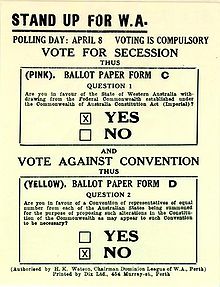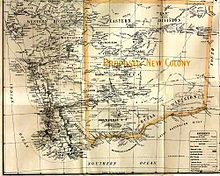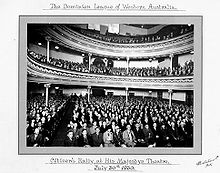- Sécessionnisme en Australie-Occidentale
-
Le sécessionnisme a été une caractéristique récurrente du paysage politique d'Australie-Occidentale depuis la colonisation européenne en 1829. L'idée d'auto-gouvernance ou la sécession a souvent été discutée à travers des articles et des éditoriaux de journaux locaux et, à plusieurs reprises, a fait surface au cours d'événements très médiatisés dont un référendum d'État en 1933. Des groupes organisés ont été créés pour agir quand le calendrier était à leur avantage.
Les arguments en faveur de la sécession sont fondés sur l'hypothèse selon laquelle un gouvernement fédéral basé à Canberra favorisera les intérêts commerciaux et populaires d'une plus large partie de la population. On a dit que l'Australie-Occidentale est un oublié, un État-Cendrillon — contribuant davantage aux fonds fédéraux qu'il n'en bénéficie —, et est victime de discrimination de la part des États les plus peuplés.
Dans l'économie moderne, l'Australie-Occidentale est l'État le plus productif en ce qui a trait au revenu par habitant : 45 277 $ en 2003-2004 par rapport à la moyenne nationale de 39 234 $[1].
Sommaire
Auto-gouvernance coloniale
Des pétitions demandant des élections représentatives pour certains des postes au Conseil législatif d'Australie-Occidentale furent présentées à Londres en 1865 et 1869. Cela est accordé en 1870, mais le droit de veto du gouverneur est maintenu.
En 1887, une nouvelle constitution incluant le droit d'auto-gouvernance est rédigée et, en 1890, la loi prévoyant l'autonomie gouvernementale est adoptée par la Chambre des communes britannique et sanctionnée par la reine Victoria.
Le reste du texte est en cours de traduction."Auralia" - goldfields separation movement
After several years of lobbying, in 1899 a well organised campaign in the goldfields presented a petition to Governor Lieutenant-Colonel Sir Gerard Smith entitled "Petition to Her Majesty the Queen from persons residing on the Eastern Goldfields, together with a refutation of the statements made in the petition, by Sir John Forrest" arguing the case for that region's separation from the Western Australian colony[2]. The Western Australian government led by Premier John Forrest were at the same time wavering in their support for the impending Federation due to a belief that they could hold out for a better deal for the state, while at the same time being lobbied by the other states' Federation committees for support to hold the federation referendum.
The other states' governments seized on the opportunity and the government was secretly threatened that its failure to support the Federation bill could mean approval being granted to the goldfields separatists. This, at least in part, encouraged the Western Australian government to move to join the Federation[3].
Federation
Fichier:Federal poll 1900.jpgRecord board of the West Australian showing results for the Popular Referendum on Australian Federation, 31 July 1900.In 1900, Western Australians along with the other five British colonies voted to join the Federation of Australia under the new Australian Constitution. Around 64,000 of the eligible 96,000 electors in Western Australia voted in favour of joining, but most country electorates voted 'No', except Albany and the Goldfields which voted 'Yes'.
The Constitution, which came into force on 1 January 1901 states in its opening preamble[4]:
« WHEREAS the people of New South Wales, Victoria, South Australia, Queensland, and Tasmania, humbly relying on the blessing of Almighty God, have agreed to unite in one indissoluble Federal Commonwealth under the Crown of the United Kingdom of Great Britain and Ireland, and under the Constitution hereby established.
And whereas it is expedient to provide for the admission into the Commonwealth of other Australasian Colonies and possessions of the Queen ... [emphasis added] »
Western Australia was not specifically mentioned in the preamble as its support was given too late for the document to be redrafted.
1933 referendum
James MacCallum Smith, the proprietor of the local weekly newspaper, The Sunday Times started publishing pro-secessionist articles in 1907 under its editor Alfred Chandler. Smith was a committed secessionist and continued to agitate until the mid-1930s when a syndicate of mainly nationalists purchased the paper's parent company. In 1926, Smith and others established the Secession League to provide a public vehicle for advancing the secession cause.
Prior to the Great Depression in 1930, the State's major export had been wheat. However, with the depression, wheat prices plummeted and unemployment in Perth reached 30% creating economic havoc.
Also in 1930, Keith Watson founded the Dominion League which advocated secession and the creation of a separate Dominion of Western Australia. The league held numerous rallies and public meetings which tapped into the general discontent brought on by the depression.
To counter the pro-secession movement, a Federal League of Western Australia was formed which organised a 'No' campaign. They brought several high profile people to Western Australia including the Prime Minister Joseph Lyons, Senator George Pearce, and former Prime Minister Billy Hughes for a brief speaking tour of Perth, Fremantle and country centres, but often received hostile receptions. The Federalists argued for a constitutional convention to examine the state's grievances but was unable to counter the grassroots campaign of the Dominion League. The question of holding a constitutional convention was the second question asked in the referendum.
On 8 April 1933, Nationalist Premier Sir James Mitchell's government held a referendum on secession alongside the State parliamentary election. The Nationalists had campaigned in favour of secession while the Labor party had campaigned against breaking from the Federation. 68% of the 237,198 voters voted in favour of secession, but at the same time the Nationalists were voted out of office. Only the mining areas, populated by keen Federalists, voted against the move.
The new Labor government of Philip Collier sent a delegation to London with the referendum result to petition the British government to effectively overturn the previous Act of Parliament which had allowed for the creation of the Australian Federation. The delegation included the Agent General, Sir Hal Colebatch, James MacCallum Smith, and Keith Watson. They argued as follows:
« Our opponents lay great stress on the words contained in the preamble to the Commonwealth of Australia Constitution Act:
- Have agreed to unite in one indissoluble Federal Commonwealth under the Crown of the United Kingdom of Great Britain and Ireland and under the Constitution hereby established.
They emphasise the word "indissoluble". We insist on the equal importance of the rest of the section: "Under the Crown" and "under this Constitution". Will it be contended that if - a highly improbable suggestion - the always loyal Commonwealth of Australia decided to break away from the British Crown and establish a republic, we in Western Australia should still be bound in the "indissoluble Federal Commonwealth?
Our contention is that the words "under the Constitution hereby established" are of equal significance, and if we can demonstrate - as we are prepared to do - that in a number of essentials, the Constitution has been violated to our detriment, we are entitled to be relieved from our bargain. The federation is a partnership between six States in which certain guarantees were given and certain safeguards were provided. We can show that these guarantees have been violated - that these safeguards have been swept aside - and so we ask for the annulment of the partnership.
After all, what does the word "indissoluble" mean? Remember that it occurs only in the preamble and not in the Act itself. Is any arrangement made in this world indissoluble? Can the rulers of any country 'dressed in a little brief authority', bind the people of that country not merely to the third and fourth generation, but for all time? Is there either justice or common sense in continuing an agreement that is working badly? Is a party to that agreement - after giving it a trial for 35 years and having proved it to be hampering to its industries, destructive to its prosperity and a grave bar to its development - prohibited from seeking relief? [5] »
The British House of Commons set up a high-powered committee to consider the issue but after 18 months of negotiations and lobbying, finally refused to consider the matter, further declaring that it could not legally grant secession. The delegation returned home empty-handed.
As a consequence of the failure of negotiations and of the economic revival, the League gradually lost support and by 1938 had ceased to exist.
1974 Westralian Secession Movement
Iron Ore magnate Lang Hancock founded the Westralian Secession Movement in 1974. His group focused largely on taxes and tariffs, arguing that trade barriers around Australia harmed the State's mainly mining and wheat export industries which earned a disproportionate amount of Australia’s foreign exchange. In the 1974 Senate election, the party fielded Don Thomas as an ultimately unsuccessful candidate.
The Western Australian economy was however in an upswing at the time with major capital works underway and prosperity at an all-time high. The movement stagnated after a few years.
Situation actuelle
Le 22 octobre 2008, lors d'une conférence publique, l'ancien Premier ministre d'Australie-Occidentale, Richard Court a indiqué que le mouvement sécessionniste était fortifié seulement par le gouvernement fédéral qui continue d'exploiter l'économie de l'État riche en ressources naturelles et ne parvient pas à partager la prospérité équitablement. Il a soutenu que l'Australie-Occidentale intervenait pour 35% des recettes d'exportation du pays mais que la plupart de ces recettes étaient utilisées pour renforcer le muscle financier grossissant de plus en plus de Canberra. L'État abrite environ 9 à 10% de la population du pays, génère plus de 10% des recettes mais ne reçoit que 6% des sommes distribuées. Court a souligné que si le gouvernement fédéral continue sur la voie actuelle, en 2020 l'Australie-Occidentale ne recevra que 5% des sommes distribuées par la Commission des subventions du Commonwealth. L'ancien premier ministre a déclaré qu'il ne préconisait pas la sécession, mais il a souligné qu'il fallait résoudre le déséquilibre financier et qu'il était « temps de le faire maintenant ».
Voir aussi
- Proposals for new Australian States
- Principality of Hutt River
- Référendum de 1933 en Australie-Occidentale
Footnotes
- (en) An Economic History of Western Australia since Colonial Settlement, Department of Treasury and Finance, 2004. Consulté le 2006-10-01
- "Auralia", Library and Information Service of Western Australia. Consulté le 2006-08-14
- Erreur dans la syntaxe du modèle Article« Separation movement on the Eastern Goldfields, 1894-1904 », dans Journal and proceedings Western Australian Historical Society 1949, vol.4, part 5(1953), p. 41–58
- The Attorney-General's Department, « Preamble to the Australian Constitution ». Consulté le 2006-04-21
- Library and Information Service of Western Australia, « Secession 1929-1939: London ». Consulté le 2006-05-02
Références
- 1925 to 1950: From Federation to Thoughts on Secession. Consulté le 2006-04-20
- Western Australia and Federation. Consulté le 2006-04-20
Further reading
- http://www.liswa.wa.gov.au/federation/000_bibl.htm A collection of primary sources relating to secession at the J S Battye Library
- http://www.liswa.wa.gov.au/federation/iss/index.htm
- http://www.law.mq.edu.au/html/MqLJ/Volume3/Vol3_Musgrave.pdf
- http://www.fergco.com/~samgriffith/papers/html/volume3/v3chap5.htm - Geoffrey Bolton
- http://www.fergco.com/~samgriffith/papers/html/volume3/v3chap6.htm - Campbell Sharman
- http://www.curriculum.edu.au/ddunits/units/ms4fq3acts.htm#4act2
- Stateline - Norman Moore talks secession
- (en) Cet article est partiellement ou en totalité issu de l’article de Wikipédia en anglais intitulé « Secessionism in Western Australia » (voir la liste des auteurs)
Wikimedia Foundation. 2010.





